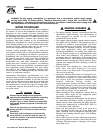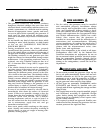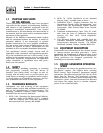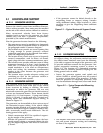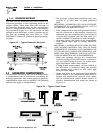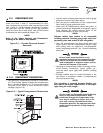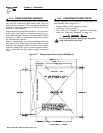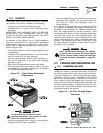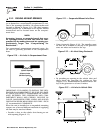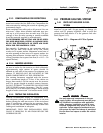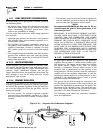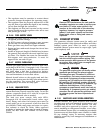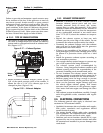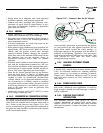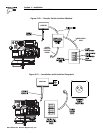
Generac
®
Power Systems, Inc. 23
Section 2 – Installation
IMPACT-36 plus II Recreational Vehicle Generator
2.2.5 ACOUSTICS
If excessive noise levels should become a problem,
the installer may wish to consider the following:
• Using special sound insulating materials.
• Construction of a special noise abatement com-
partment.
IMPORTANT: ANY METHOD USED TO REDUCE
NOISE MUST NOT ADVERSELY AFFECT THE
FLOW OF COOLING AND VENTILATING AIR INTO
OR OUT OF THE COMPARTMENT.
In addition to the effective use of sound insulating
materials, construction of a special noise abatement
compartment might be considered to reduce noise
levels. Such a compartment might be constructed as
follows (Figure 2.8):
• Use 5/8-inch thick or 3/4-inch thick plywood in the
compartment.
• Construct the compartment floor of a double thick-
ness of 5/8-inch or 3/4-inch plywood.
• Line the compartment interior walls and floor, as
well as the underside of the floor, with 26-gauge
galvanized steel.
• Vapor seal all compartment seams and joints.
• Over the galvanized steel lining, install a selected
combination of acoustical materials as mentioned
in “Sound Insulating Materials.”
Figure 2.8 — Typical Noise Abatement
Compartment
Do not install any insulation or other
absorbent materials on the interior or under-
side of the compartment floor.
• Seal all compartment door edges to prevent noise
leakage around the door perimeter.
• Line the compartment door interior (except for air
openings) with suitable, fire proof sound insula-
tion (such as 1-inch thick fiberglass with a 2-
pound density).
It is absolutely essential that an adequate flow of air
for cooling, ventilating and engine combustion be
supplied to the generator set. Without sufficient air
flow, the engine-generator quickly overheats. Such
overheating can cause serious operating difficulties
and may also cause fire and personal injury. The
installer must make sure that sufficient air is avail-
able to the generator for cooling, ventilating and com-
bustion. The installer must also provide for a path
for exhausting the cooling air to the exterior of a com-
partment, if so equipped.
Never use discharged cooling air for heating
or permit such air to enter the vehicle interior.
This air contains deadly carbon monoxide gas
and other poisonous, flammable or explosive
gases.
2.3 COOLING AND VENTILATING AIR
2.3.1 GENERATOR AIR FLOW
Engine operation drives cooling fans for the 2-stage
cooling air system. A pressure fan draws cooling air
into the top of generator and into the side of the con-
trol panel (Figure 2.9). This air flow cools the engine-
generator and electronic components. The second
part of the cooling system, a suction fan, draws air
that is heated from a hot engine into a collector pan
at the base of the unit. This heated air (although cool-
er than exhaust muffler) is directed across the muf-
fler to cool it. The heated air flow is then deflected out
the bottom toward the ground.
Figure 2.9 — Air Flow Through Engine-
Generator
◆
DANGER
!
DANGER
◆




